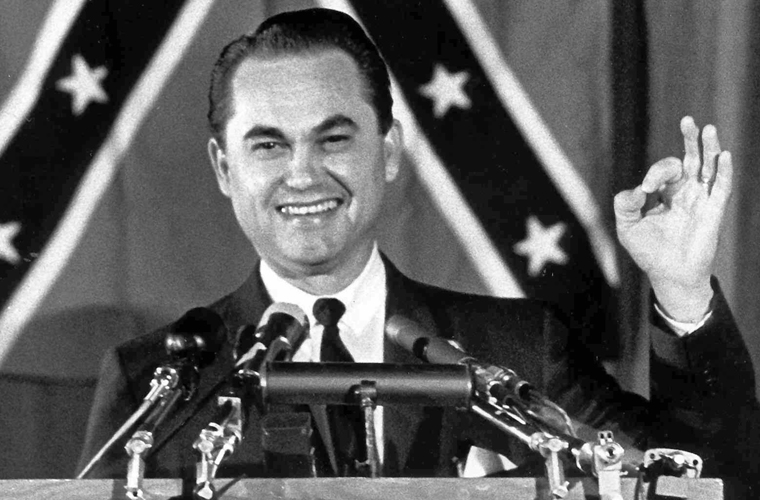George C. Wallace was a four-time governor of Alabama and three-time presidential hopeful. He is best remembered for his 1960s segregationist politics. George C. Wallace was born in Clio, Alabama, on August 25, 1919. After law school and military service, he embarked on a career as a judge and local politician. He served four terms as Alabama governor, from the 1960s through the 1980s, and ran unsuccessfully for the U.S. presidency three times. Despite his later efforts to revise his public image, Wallace is remembered for his strong support of racial segregation in the ’60s. He died in Montgomery, Alabama, on September 13, 1998.
George Corley Wallace Jr. was born on August 25, 1919, in Clio, Alabama. His father, George Corley Sr., was a farmer. His mother, Mozelle Smith Wallace, had been abandoned by her mother and raised in an orphanage in Mobile as a young girl. Wallace took up boxing as a boy and won two Golden Gloves state titles while he was a student at Barbour County High School. When he was 15 years old, he served as a legislative page at the Alabama State Capitol in Montgomery. He enrolled at the University of Alabama School of Law in 1937 and graduated with a law degree in 1942.
After graduating from law school, Wallace entered the U.S. Army Air Corps and served during World War II. He flew multiple bombing missions over Japan in 1945 and was later discharged with a medical disability. Returning to Alabama, Wallace reunited with his wife, Lurleen (née Burns), whom he’d married in 1943. Deciding to enter local law and politics, Wallace became an assistant to the state attorney general in 1946. The following year, he was elected to the Alabama State Legislature, where he served for two terms. In 1953, Wallace was elected judge in the Third Judicial Circuit Court of Alabama—a position that he held through 1958. He was given the nickname “The Fighting Little Judge” in reference to his boxing days and his tough approach to his work.
Meanwhile, Wallace was making plans to run for the governorship of his home state. He lost at his first attempt, in 1958. In 1962, when he ran again on a platform of racial segregation and states’ rights and was backed by the Ku Klux Klan, he won the election. His inaugural speech concluded with the infamous line, “Segregation now, segregation tomorrow, segregation forever.”In another event of 1963 that cemented the public perception of the new Alabama governor, Wallace led a “stand-in the schoolhouse door” to prevent two black students, Vivian Malone, and James Hood, from enrolling at the University of Alabama, until the National Guard intervened. He continued to oppose integration throughout his term.
In 1964, Wallace briefly entered the primaries for the presidential race, although he lost in the three states in which he appeared on the ballot. He dropped out of contention shortly thereafter, but he used his third-party foothold to run three times in the future. When the Alabama legislature refused to change the state Constitution to allow him to run for a second term, Wallace put his wife, Lurleen, on the ballot in his place in 1966. After winning a landslide election, she died in office in 1968. Wallace himself was elected again in 1970 and won two more elections in 1974 and 1982—becoming the first individual (and only person to date) to fill four terms as governor of Alabama.
Wallace also harbored presidential aspirations. In 1968, he ran as an Independent candidate, supported mainly by white, working-class Southerners. In his 1972 campaign, however, he ran as a Democrat. While on the campaign trail in Maryland later that year, Wallace was shot by a would-be assassin named Arthur Bremer. His injuries left him permanently paralyzed below the waist. He managed to still complete the campaign but ultimately lost the Democratic nomination to George McGovern (who then lost the presidential election to Richard Nixon).In his third and final presidential attempt, in 1976, Wallace again ran as a Democrat; he was defeated in the primaries by fellow Southerner Jimmy Carter.
From the late 1970s onward, Wallace attempted to revise his public image by modifying his previous position on race issues. He claimed that many of his statements had been misunderstood, and he emphasized his populist leanings. In some cases, he issued public apologies for his earlier actions. By the time of his fourth term as Alabama governor, he’d begun receiving a substantial amount of support from black political organizations and black voters. His efforts to improve the state’s economy, health care, employment, and infrastructure were considered highly successful. Due to ill health, Wallace retired at the end of his last gubernatorial term, in January 1987. He died of heart failure on September 13, 1998, at the age of 79, in Montgomery, Alabama. Wallace had married three times. In addition to his marriage to Lurleen Burns, with whom he had four children, he wed Cornelia Ellis Sniveley in 1971 (divorced in 1978) and Lisa Taylor in 1981 (divorced in 1987).

